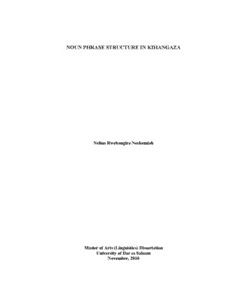
Noun Phrase Structure in Kihangaza PDF
Preview Noun Phrase Structure in Kihangaza
NOUN PHRASE STRUCTURE IN KIHANGAZA Nelius Rwebangira Neckemiah Master of Arts (Linguistics) Dissertation University of Dar es Salaam November, 2010 NOUN PHRASE STRUCTURE IN KIHANGAZA By Nelius Rwebangira Neckemiah A Dissertation Submitted in (Partial) Fulfilment of the Requirements for the Degree of Master of Arts (Linguistics) of the University of Dar es Salaam University of Dar es Salaam November, 2010 i CERTIFICATION The undersigned certifies that he has read and hereby recommends for acceptance by the University of Dar es Salaam the dissertation entitled: Noun Phrase Structure in Kihangaza, in partial fulfilment of the requirements for the degree of Master of Arts (Linguistics) of the University of Dar es Salaam. …… ……………………………………………….. Prof. Y.M. Kihore (Supervisor) ……………………………… Date ii DECLARATION AND COPYRIGHT I, Nelius Rwebangira Neckemiah, declare that this dissertation is my own original work and that it has not been presented and will not be presented to any other University for a similar or any other degree award. ………………………………… Signature …………………………………. Date This dissertation is copyright material protected under the Berne Convention, the Copyright Act 1999 and other International and national enactments, in that behalf, on intellectual property. It may not be reproduced by any means, in full or in part, except for short extracts in fair dealings, for research or private study, critical scholarly review or discourse with an acknowledgement, without the written permission of the Director, Postgraduate Studies on behalf of both the author and the University of Dar es Salaam. iii ACKNOWLEDGMENTS I would like to express my sincere gratitude to all those who, in one way or the other, helped make this work a success. Their combined comments and criticisms helped greatly in shaping it. First of all, I am greatly indebted to my supervisor Prof. Y.M Kihore for his good guidance when I was carrying out my work. His enthusiastic supervision enabled me to accomplish much. In the same way, I wish to extend my distinguished thanks to Prof. D.J.Mkude whose contribution and the time he devoted to my work cannot be measured. Furthermore, I would like to thank my colleagues at the Dar es Salaam University College of Education for their constructive ideas. I would, therefore, wish many thanks to go to Manyasa Jonace, Cosmas Constantine and other colleagues whose names are not mentioned here. I also owe many thanks to the languages of Tanzania (LoT) Project for its remarkable financial aid without which the pursuance of my MA. Linguistics and the writing of my dissertation would not be a reality. This financial aid made all this possible. I am also very grateful to all my respondents whose contribution cannot be disregarded. Their willingness to provide me with information is highly treasured. Finally, I am grateful to my dear wife, Placidia Justace Wamala for her moral and iv psychological support. She assiduously encouraged me whenever I felt tired. Moreover, she took care of our beloved children, Nicas and Nixon. v DEDICATION This work is dedicated to my beloved father Neckemiah Fundi and my deceased mother Melensiana, for their long time parental care and guidance without which my work would not be a success. vi ABSTRACT This study focuses on the description of the noun phrase structure (henceforth NP) in Kihangaza using the X-bar theory which is a component of the Phrase Structure Grammar. It aims at providing a precise identification of the category NP in this language, establishing the criteria for categorising elements that can become its dependents, showing the extent to which the noun can be projected as well as examining the features of the NP that contribute to new knowledge. In terms of research methodology, the data was collected through questionnaire, interviews, text analysis, free conversations and story telling. As regards the analysis of the data, the morphosyntactic approach is taken aboard in order to achieve the intended objectives of the study. In this approach, the Kihangaza nouns and other elements, some of which operate as noun dependents, were morphologically and syntactically analysed in order to shed light on the morpho-syntactic relations that the noun head has with its dependents. Findings from the study reveal that members of word classes in Kihangaza NP and other Bantu languages can best be determined based on Bantu inflection. It is further revealed that based on this criterion, the dependents of the head noun in the NP may be clustered into 2 categories, namely: pronominals and adjectives. vii TABLE OF CONTENTS Page Certification……………………………………………………………………………i Declaration and Copyright…………………………………………………………….ii Acknowledgments…………………………………………………………………….iii Dedication………………………………………………………………………………v Abstract………………………………………………………………………………...vi Table of Contents……………………………………………………………………..vii List of Tables……………………………………………………….............................xii List of Figures………………………………………………………………………..xiii List of Abbreviations and Symbols…………………………………………………..xiv Appendices…………………………………………………………………………..xvii CHAPTER ONE: GENERAL INTRODUCTION 1.0 Background Information on the Language and its Speakers………………………1 1.1 Background to the Problem………………………………………………………..5 1.2 Statement of the Problem………………………………………………………….6 1.3 Research Objectives……………………………………………………………….6 1.4 The Significance of the Study……………………………………………………..7 1.5 Limitations of the Study…………………………………………………………...7 1.6 Scope of the Study………………………………………………………................8 1.7 Plan of the Study………………………………………………………..................8 viii 1.8 Conclusion…………………………………………………………………………8 CHAPTER TWO: THEORETICAL FRAMEWORK AND LITERATURE REVIEW 2.0 Introduction…………………………………………………..…………………...10 2.1 Literature Review …...............................................................................................10 2.1.1 Introduction ………………………………………………………………….…10 2.1.2 The Realisation of the Category NP in Various Languages ……………….….10 2.2 Theoretical Framework ………………………………………………………….17 2.2.1 General Overview of the Category Noun Phrase ……………………………...17 2.2.2 Theoretical Realisation of the Category NP……………………………….…..18 CHAPTER THREE: RESEARCH METHODOLOGY 3.0 Introduction……………………………………………………………………....30 3.1 Location of the Study Area………………………………………………………30 3.2 Research Design………………………………………………………………….31 3.3 Sampling Size and Identification of Respondents…………………………….....31 3.4 Methods of Data Collection……………………………………………………...32 3.5 Data Analysis Procedures……………………………………………………......33 3.6 Conclusion………………………………………………………………………..33
